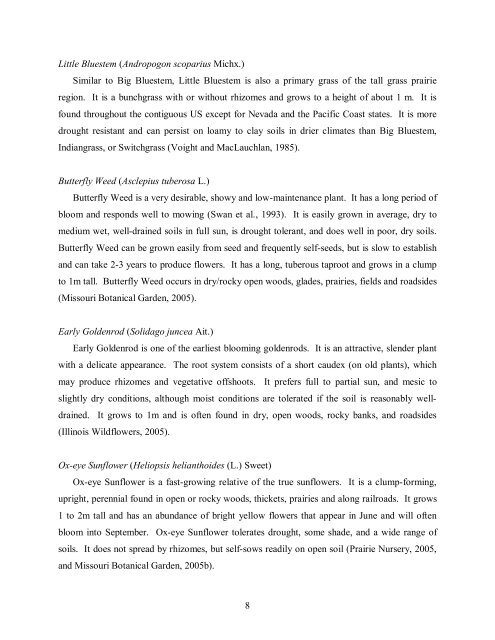The Use of Native Plants for Revegetation along West Virginia ...
The Use of Native Plants for Revegetation along West Virginia ...
The Use of Native Plants for Revegetation along West Virginia ...
Create successful ePaper yourself
Turn your PDF publications into a flip-book with our unique Google optimized e-Paper software.
Little Bluestem (Andropogon scoparius Michx.)<br />
Similar to Big Bluestem, Little Bluestem is also a primary grass <strong>of</strong> the tall grass prairie<br />
region. It is a bunchgrass with or without rhizomes and grows to a height <strong>of</strong> about 1 m. It is<br />
found throughout the contiguous US except <strong>for</strong> Nevada and the Pacific Coast states. It is more<br />
drought resistant and can persist on loamy to clay soils in drier climates than Big Bluestem,<br />
Indiangrass, or Switchgrass (Voight and MacLauchlan, 1985).<br />
Butterfly Weed (Asclepius tuberosa L.)<br />
Butterfly Weed is a very desirable, showy and low-maintenance plant. It has a long period <strong>of</strong><br />
bloom and responds well to mowing (Swan et al., 1993). It is easily grown in average, dry to<br />
medium wet, well-drained soils in full sun, is drought tolerant, and does well in poor, dry soils.<br />
Butterfly Weed can be grown easily from seed and frequently self-seeds, but is slow to establish<br />
and can take 2-3 years to produce flowers. It has a long, tuberous taproot and grows in a clump<br />
to 1m tall. Butterfly Weed occurs in dry/rocky open woods, glades, prairies, fields and roadsides<br />
(Missouri Botanical Garden, 2005).<br />
Early Goldenrod (Solidago juncea Ait.)<br />
Early Goldenrod is one <strong>of</strong> the earliest blooming goldenrods. It is an attractive, slender plant<br />
with a delicate appearance. <strong>The</strong> root system consists <strong>of</strong> a short caudex (on old plants), which<br />
may produce rhizomes and vegetative <strong>of</strong>fshoots. It prefers full to partial sun, and mesic to<br />
slightly dry conditions, although moist conditions are tolerated if the soil is reasonably welldrained.<br />
It grows to 1m and is <strong>of</strong>ten found in dry, open woods, rocky banks, and roadsides<br />
(Illinois Wildflowers, 2005).<br />
Ox-eye Sunflower (Heliopsis helianthoides (L.) Sweet)<br />
Ox-eye Sunflower is a fast-growing relative <strong>of</strong> the true sunflowers. It is a clump-<strong>for</strong>ming,<br />
upright, perennial found in open or rocky woods, thickets, prairies and <strong>along</strong> railroads. It grows<br />
1 to 2m tall and has an abundance <strong>of</strong> bright yellow flowers that appear in June and will <strong>of</strong>ten<br />
bloom into September. Ox-eye Sunflower tolerates drought, some shade, and a wide range <strong>of</strong><br />
soils. It does not spread by rhizomes, but self-sows readily on open soil (Prairie Nursery, 2005,<br />
and Missouri Botanical Garden, 2005b).<br />
8












